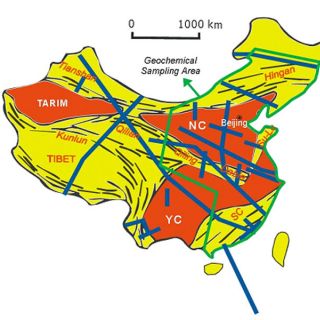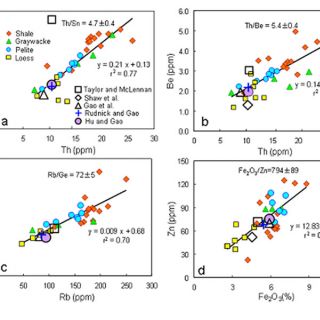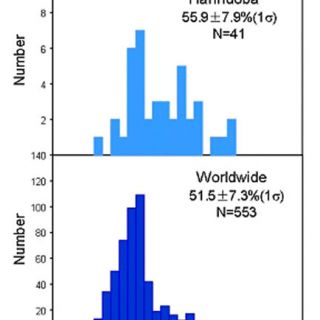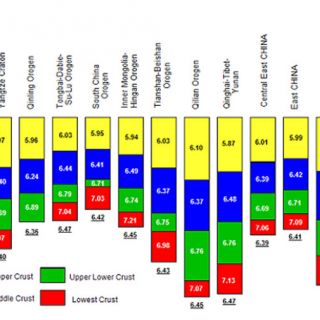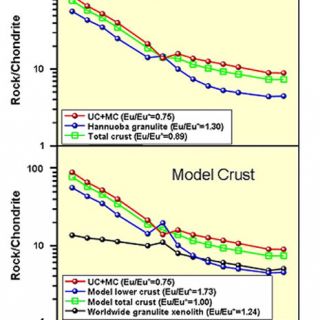Shan Gaoa,b,*
a State Key Laboratory of Geological Processes and Mineral Resources, Faculty of Earth Sciences, China University of Geosciences, Wuhan, 430074, P.R. China
b State Key Laboratory of Continental Dynamics, Department of Geology, Northwest University, Xi'an, 710069, P.R. China
* corresponding author's email: sgao@263.net
Full Text (3.7 Mb PDF)
Abstract
The chemical composition of the continental crust is critically important for understanding its formation and evolution and, ultimately, understanding Earth differentiation. Here we provide a brief review of the chemical composition of the continental crust, with an emphasis on studies from China. The upper crustal composition reveals higher transition metal abundances compared to previous estimates that were based on results from the Canadian Shield. Inter-element correlations in clastic sedimentary rocks can be extended to many immobile as well as mobile elements. The significant correlations place constraints on the concentrations of the rarely analyzed elements (B, Be, Bi, Ge, In, Mo, Sb, Sn, Te, Tl, W) in the upper crust. Middle crustal compositional estimates based on sampling of amphibolite-facies rocks and seismic profiles yield a bulk composition with 62-69% SiO2. The eastern China middle crust composition is more evolved and shows slightly slower compressional velocity than that of global middle crust. While there is a general consensus that the global lower continental crust is mafic in composition, eastern China is a remarkable exception to this generality with an intermediate bulk lower crust composition. The total crust composition of eastern China is also more evolved than the global model and characterized by a significant negative Eu anomaly. Delamination of the lower crust and its underlying lithospheric mantle are suggested to have played an important role in driving the continental crust to an evolved composition, loss of the Archean keel, and in producing the large volumes of intraplate magmatism in the North China Craton during the Mesozoic.
Keywords: Continental crust, chemical composition, seismic velocity, delamination, eastern China
1. Introduction
The composition of the continental crust is critically important for understanding its formation and evolution and ultimately, understanding Earth's differentiation, and for quantifying geodynamic processes within the Earth (e.g., Taylor and McLennan, 1995, 2009; Rudnick, 1995; Gao et al., 1998a; Rundick and Gao, 2003; Hawkesworth and Kemp, 2006a, b). It also provides baselines for assessing geochemical anomalies in exploration of ore deposits and environmental and agriculture investigations. For these reasons, determining the chemical composition of the continental crust has been an aim of geochemists since the first analyses of rocks were undertaken (Clarke, 1889).
The continental crust can be divided into upper, middle and lower layers and shows wide lithological and geochemical variations. The upper crust is readily accessible for direct sampling and its composition is reasonably well established for the major elements and many lithophile trace elements. In comparison, the composition of the deep (middle and lower) crust is less well established due to its general inaccessibility. Here we provide a brief review of the chemical composition of the continental crust, with an emphasis on studies from China. For detailed reviews of composition of the continental crust in the global context see Rudnick and Gao (2003) and Taylor and McLennan (2009).
2. The Upper Crust
Two approaches have generally been used to determine the composition of the upper continental crust (ref. Rudnick and Gao, 2003; Taylor and McLennan, 2009). One is to establish weighted averages of the compositions of rocks exposed at the surface by large-scale sampling campaigns. All major-element determinations of upper-crust composition rely upon this method. The other approach is to determine the average concentrations of insoluble elements in fine-grained clastic sediments and sedimentary rocks (e.g., shale, mudstone, graywacke, siltstone, loess, and tillite) and use these to infer the average composition of their source regions.
2.1 Weighted Averages of Exposed Crust
The Canadian Shield represents the first area in which large-scale sampling of the crust was undertaken for both major and trace element analyses (Shaw et al., 1967, 1976, 1986; Eade and Fahrig, 1971, 1973). More recently, two campaigns of systematic large-scale sampling and rock analyses were undertaken in eastern China in the 1980's and 1990's for the purpose of studying the chemical composition of the continental crust. The first was carried out in the Qinling orogen and the adjacent regions of the North China Craton and Yangtze Craton. The sampling covered an area of 153,200 km2 and comprised over 4500 individual rock samples that represented all of the Late Archean to Neogene stratigraphic units, the 2/3 of the exposed granitoids, as well as all of the major mafic-ultramafic intrusions in the study area. These individual rocks were analyzed for thirteen major and thirty trace and rare earth elements. The results were used, in conjunction with seismic velocities of the deep crust and surface heat flow, to estimate the composition of the upper, deep and total crust of the Qingling region (Gao et al., 1992; Zhang et al., 1994).
A second round of large-scale sampling was conducted over most of eastern China, covering a total area of ca 3,300,000 km2 (Fig. 1) (Yan et al., 1997; Yan and Chi, 1997; Gao et al., 1998b; Zhang et al., 2002). A total of 28,253 individual rocks were sampled, from which 2,718 composite samples were prepared based on age, lithology and tectonic units. Between sixty-three to seventy-six major and trace elements were analyzed by a variety of methods, including elements that are rarely analyzed (e.g., Ag, As, Bi, Br, Cd, Cl, F, Ge, Hg, I, In, Mo, PGE, Te, Se, W) (Yan et al., 1997; Yan and Chi, 1997; Gao et al., 1998b; Zhang et al., 2002).
These studies revealed higher transition metal abundances of the upper crust compared to previous estimates that were based on results from the Canadian Shield studies (Shaw et al., 1967, 1976, 1986; Eade and Fahrig, 1971, 1973; Taylor and McLennan, 1985; Wedepohl, 1995). A higher transition metal content of the upper crust has been supported by subsequent studies of fine-grained clastic sedimentary rocks (Condie, 1993; Plank and Langmuir, 1998; McLennan, 2001; Hu and Gao, 2008; Taylor and McLennan, 2009). The discrepancies between the Canadian Shield and eastern China studies were ascribed to differential erosion. The present-day surface of the Canadian Shield is dominated by amphibolite-facies granitoid gneisses, which are more typical of middle crust than upper crust. The uppermost crust of Archean regions typically contains more mafic volcanic rocks (Gao et al., 1998b). By contrast, unmetamorphosed to greenschist-facies rocks are well preserved in eastern China.
The influence of erosion on the upper crust composition was also demonstrated by Condie (1993), who added a 10 km thick layer of upper crust in Precambrian areas and a 5 km thick layer of upper crust in Phanerozoic areas to the present upper crust layer. This restoration model for the upper continental crust composition shows a remarkably good agreement with the eastern China upper crust composition in terms of Nb, Rb, Th, Zr, Co, Sc, and V, as well as K2O concentrations. Although the Cr and Ni abundances of the restoration model are significantly greater than the eastern China estimates, the difference is small compared to estimates based on the Canadian Shield. We conclude that eastern China surface samples are a good representation of the average upper continental crust (Gao et al., 1992, 1998b).
Another important observation from eastern China is that various thicknesses of sedimentary cover, including carbonate, are an important component of the upper continental crust. Because carbonate and silicate rocks vary greatly in their chemical compositions and since the sedimentary cover in eastern China contains a significantly higher carbonate proportion with a carbonate/(pelite+sandstone) ratio of 0.31-2.23 compared to the global ratio of 0.18 (Taylor and McLennan, 1985), the upper crust compositions with and without carbonate are distinct in major elements (e.g., 58.5 vs 65.5% for SiO2 and 7.41 vs 3.31 for CaO) (Gao et al., 1998b). However, because carbonates have low abundances of trace elements, excepting Sr, the two estimates of the upper crust do not vary in relative trace element abundances (Yan et al., 1997; Gao et al., 1998b). The major element compositions without carbonate are also similar to previous estimates (Gao et al., 1998b).
In addition, trace elements associated with mineralization (e.g., B, Cl, Se, As, Bi, Pd, W, Th, Cs, Ta, Tl, Hg, Au, and Pb) show considerable inter-unit variability (by a factor of 2-5) in the upper crust (Gao et al., 1998b).
2.2 Fine-Grained Sedimentary Rocks
Estimates of the upper crustal composition from fine-grained clastic sedimentary rocks were applied by Taylor and McLennan (1985) to trace elements that are immobile during water-rock interaction and are not hosted in accessory minerals and, thus, are little fractioned during sedimentary processing and diagenesis. Such elements include REE, Y, Th, and Sc. The more mobile elements, such as K, U and Rb, can be estimated from assumed Th/U, K/U and K/Rb ratios (Taylor and McLennan, 1985). The fine-grained sediment approach has more recently been extended to elements such as Nb, Ta, Cs and transition metals (Cr, Ni, V, Co and Ti) (McDonough et al., 1992; Plank and Langmuir, 1998; Barth et al., 2000; McLennan, 2001).
In a recent study, Hu and Gao (2008) analyzed 48 trace elements by ICP-MS (including the rarely analyzed elements As, B, Be, Bi, Cd, Ge, In, Mo, Sb, Sn, Te, Tl, W) in well-characterized upper crustal samples (shales, pelites, loess, graywackes, granitoids and their composites) from Australia, China, Europe, New Zealand and North American. The results reveal that inter-element correlations in clastic sedimentary rocks can be extended to many immobile as well as mobile elements (e.g., Ga-In, Th-Sn, Rb-Tl, Th-Tl, Rb-Be, Th-Be, Rb-Ge, Rb-W, Be-Bi, W-Bi, In-Li, B-Te, Fe-transition trace metals) (Fig. 2). The significant (r2>0.6) correlations observed in clastic sediments and sedimentary rocks provide narrowly constrained upper continental crust elemental ratios, which can be used with abundances for certain key elements to place constraints on the concentrations of these rarely analyzed elements in the upper crust. Using the well-established upper crustal abundances of La (31 ppm), Th (10.5 ppm), Al2O3 (15.40%), K2O (2.80%) and Fe2O3 (5.92%), these correlations lead to revised upper crustal abundances for B=47 ppm, Li=41 ppm, Cr=73 ppm, Ni=34 ppm, Sb=0.075, Te=0.027 ppm, W=1.4 ppm. Tl=0.53 ppm and Bi=0.23 ppm. No significant correlations exist between Mo and Cd and other elements in the clastic sediments and sedimentary rocks, probably due to their enrichment in organic carbon. If we assume that these two incompatible elements behave more or less like REE and Th, their abundances can be calculated by assuming the upper continental crust consists of 65% granitoid rocks plus 35% clastic sedimentary rocks. The validity of this bulk average approach for incompatible elements is supported by the similarity of SiO2, Al2O3, La and Th abundances calculated in this way with their upper crustal abundances given in Rudnick and Gao (2003). The upper crustal abundances thus obtained are Mo=0.6 ppm and Cd=0.06 ppm. The data also suggest a ~20% increase of the Tm, Yb and Lu abundances reported in Rudnick and Gao (2003).
In summary, studies of surface samples from eastern China and clastic sediments establish significantly higher upper crustal abundances of transition metals compared to those based on surface samples from the Canadian Shield. The upper crustal compositions of the major elements and a majority of trace elements, as well as some key elemental ratios are well established. Such estimates can form basis of mass balance calculations for the Earth and provide geodynamic insights (e.g., Rudnick et al., 2000). However, the upper crustal abundances of some elements, notably platinum group elements, noble gases and the halogens are still highly uncertain.
3. The Deep Crust
Major uncertainties in the composition of the continental crust lie in the deep continental crust and particularly the lower crust, as it is far less accessible than the upper crust. Four approaches have been used to infer its composition (ref. Rudnick and Gao, 2003): (1) analyses of high-grade metamorphic (amphibolite or granulite facies) terrains and exposed crustal cross-sections in particular; (2) studies of granulite-facies xenoliths entrained in fast-rising magmas; (3) correlation of measured seismic velocities of deep crustal rocks with seismic profiles of the crust; and (4) surface heat flow measurements.
Studies of exposed crustal cross-sections and xenoliths indicate that, although exceptions exist, the middle crust is dominated by rocks metamorphosed at amphibolite-facies to lower granulite facies, while the lower crust consists mainly of granulite-facies rocks (Rudnick and Gao, 2003 and references therein). Exposed amphibolite- to granulite-facies terrains and middle crustal cross-sections show that, although they contain a wide variety of lithologies, including metasedimentary rocks, they are dominated by igneous and metamorphic rocks of the diorite-tonalite-trondhjemite-granodiorite (DTTG) and granite suites. This is true not only for Precambrian shields, but also for Phanerozoic crust and continental arcs. Such rock associations are consistent with the average middle crustal P-wave velocities of 6.4-6.5 km s-1 seen in all the tectonic settings except for active rifts and some intra-oceanic island arcs, which have higher average velocities suggesting a more mafic composition (Rudnick and Fountain, 1995).
Middle crust compositional estimates based on sampling of amphibolite-facies rocks and seismic profiles yield a bulk composition with 62-69% SiO2. Trace element composition of the middle crust is poorly constrained, as systematic trace element studies of amphibolite-facies rocks are few. Nevertheless, the estimates of Rudnick and Fountain (1995) based on lithologies derived from seismic velocities and Gao et al. (1998b) based on eastern China surface sampling show a broadly similar composition in both major and trace elements, although the eastern China middle crust composition is more evolved, having higher SiO2, K2O, Ba, Li, Zr, and LREE and LaN/YbN and lower total FeO, Sc, V, Cr and Co with a significant negative Eu anomaly. These differences are expected based on the slightly higher compressional velocity of Rudnick and Fountain's global middle crust compared to that of eastern China (6.6 vs. 6.4 km s-1: Gao et al., 1998a, b). The consistency is surprising, considering that the two estimates are based on different sample sets and different approaches, one global and the other regional (Rudnick and Gao, 2003).
Like the middle crust, the lower crust also contains a wide variety of lithologies, as revealed by studies of granulite xenoliths, exposed high-pressure granulite terranes and crustal cross sections. Nevertheless, mafic rocks appear to dominate in the lower crust based on the relatively high seismic velocities, which are faster than 6.9 km s-1 (mostly ≥7.0 km s-1) for various tectonic units (Rudnick and Fountain, 1995).
While there is a general consensus that the global lower continental crust is mafic in composition (ref. Rudnick and Fountain, 1995; Christensen and Mooney, 1995), Eastern China is a remarkable exception to this generality. Studies of exposed lower crustal cross-section and lower crustal granulite-facies xenoliths in eastern China indicate a bimodal lithological distribution in the lower crust, with felsic rocks being an important constituent, as exemplified by the Hannuoba granulite xenoliths, which have an average SiO2 of 56% (Kern et al., 1995; Liu et al., 2001). This is unlike the worldwide compilations of lower crustal xenoliths, which are predominately mafic (Rudnick and Presper, 1990; Rudnick and Fountain, 1995) with an average SiO2 of 51.5% (Fig. 3). This conclusion is supported by results of seismic profiling, which indicate a distinct two-layered structure to the lower crust for all of eastern China, except the Qingling orogen (Fig. 4). The upper lower crust has a mean velocity of 6.7 km s-1, suggesting an evolved composition; only the lowermost crust has a mean velocity that is typical of mafic rocks (average velocity = 7.1 km s-1) and is comparable to the global lower crust. The bulk lower crust of eastern China has a mean P-wave velocity of 6.82 km s-1 that is slower than the global average by 0.2-0.4 km s-1, and is consistent with an intermediate bulk composition (Gao et al., 1998a, b). The slower velocity of the lower crust of eastern China is reinforced by recent compilations of seismic profiling in China (Li et al., 2006). We conclude that the evolved lower crust composition of eastern China is well established and is a remarkable feature exceptional to the global continental crust.
4. The total crust composition and its geodynamic implications
There is a general consensus that the bulk composition of the continental crust is andesitic. All estimates of the crust composition, including the pioneering work of Clarke (1889), have a total crustal SiO2 that falls between 57.1-64.5% (Rudnick and Gao, 2003), regardless of the approaches and data sets that have been employed to derive these estimates. Moreover, all estimates show a continental crust that is characterized by enrichments in large-ion lithophile elements (e.g., Cs, Rb, Ba and, in particular, Pb) and depletions in high-field strength elements (Nb, Ta, Ti). These features are therefore considered robust and can be used to understand the formation and evolution of the continental crust.
The continental crust grows primarily by an igneous flux from the mantle, which in most cases should be basaltic. The demonstrably non-basaltic composition of the continental crust requires some form of crustal recycling through delamination, weathering and/or subduction (Rudnick, 1995).
Europium balance or imbalance in the continental crust may be useful for understanding the processes by which the crust evolved (e.g., Gao et al., 1998a; Hawkesworth and Kemp, 2006b). Mantle-derived additions to the crust would normally have no Eu anomaly. Intracrustal differentiation by granitic magmatism has led to a prominent negative Eu anomaly in the granitic upper crust (Eu/Eu*=0.72; Rudnick and Gao, 2003), and should produce a restitic lower crust with a complementary positive Eu anomaly (Taylor and McLennan, 1985, 2009). However, if delamination of the dense mafic lower crust could occur, and if this crust contained cumulate or residual plagioclase, the total crust after delamination would evolve toward a felsic composition with a negative Eu anomaly. The total crust composition estimates of Rudnick and Gao (2003) has a weak negative Eu anomaly (Eu/Eu*=0.93), which would accommodate some removal of plagioclase cumulates/restites, although given the uncertainties, there is no need to call upon plagioclase removal from the lower crust.
In contrast to the global average lower crust, the continental crust in eastern China has a pronounced negative Eu anomaly (Eu/Eu*=0.80) (Gao et al., 1998a, b). The upper and middle crusts of eastern China have Eu/Eu* of 0.73 and 0.78, respectively. Weighted by thickness, the upper plus middle crust as a whole has an average Eu/Eu* of 0.75 (Fig. 5). The Hannuoba mafic and mafic to felsic granulite xenoliths have almost identical Eu/Eu* of 1.28 and 1.30, respectively. If the eastern China lower crust is assumed to be represented by the average Hannuoba granulite xenoliths, the resultant total crust has Eu/Eu* of 0.89 (Fig. 5). This magnitude of Eu anomaly is insufficient to compensate for the negative Eu anomaly of the upper and middle crust so as to produce no Eu anomaly in the total crust. The model lower crust is required to have Eu/Eu* of 1.73 to make a balance, which is far greater than the average worldwide mafic (Eu/Eu*=1.24) and mafic to felsic granulite xenoliths (Eu/Eu*=1.14) (Fig. 5). Delamination of the lower crust plus underlying lithospheric mantle has been suggested to have occurred in eastern China based on studies of Mesozoic high-Mg adakitic magmas, picritic and basaltic lavas and entrained eclogitic xenoliths in the North China Craton (Gao et al., 2004, 2008; Xu et al., 2006). Although other models may also explain the andesitic composition of the continental crust (Rudnick and Gao, 2003; Arculus, 2006; Davidson and Arculus, 2006), we conclude that delamination of the deep lithosphere may have played an important role in driving the continental crust to an evolved composition, loss of the Archean keel, and in producing the large volumes of intraplate magmatism in the North China Craton during the Mesozoic (Gao et al., 2004, 2008; Xu et al., 2006).
Acknowledgments
I dedicate this paper to my graduate supervisor Prof. Benren Zhang. I thank the team of eastern China crust composition study for their samples and Mingcai Yan particularly for helping analysis of the composites. I also thank Roberta L. Rudnick, Zhaochu Hu, Yongsheng Liu, and Scott McLennan for their comments and discussion. I finally thank Yong-Fei Zheng and Stephen C. Komor for editorial handling. This research is supported by the National Nature Science Foundation of China (Grants 40821061, 90714010, 40973020), Chinese Ministry of Education and State Administration of Foreign Expert Affairs (B07039) as well as the MOST special funds from the State Key Laboratory of Continental Dynamics and the State Key Laboratory of Geological Processes and Mineral Resources.
References
Arculus R.J. (2006) The 'Andesite Model' of continental crust origins. Geochim. Cosmochim. Acta 70 (Issue, 18, Supplement 1), A20.
Barth M., McDonough W.F. and Rudnick R.L. (2000) Tracking the budget of Nb and Ta in the continental crust. Chem. Geol. 165, 197-213.
Christensen N. I. and Mooney W. D. (1995) Seismic velocity structure and composition of the continental crust: A global view. J. Geophys.Res. 100, 7961-9788.
Clarke F.W. (1889) The relative abundance of the chemical elements. Phil. Soc. Washington Bull XI, 131-142.
Condie K.C. (1993) Chemical composition and evolution of the upper continental crust: contrasting results from surface samples and shales. Chem. Geol. 104, 1-37.
Eade K.E. and Fahrig W.F. (1971) Chemical evolutionary trends of continental plates-preliminary study of the canadian shield. Geol. Sur. Can. Bull. 179, 1-51.
Eade K.E. and Fahrig W.F. (1973) Regional, lithological, and temporal variation in the abundances of some trace elements in the canadian shield. Geol. Sur. Canada Paper 72-46, Ottawa, Ontario.
Davidson J.P. and Arculus R.J. (2006) The significance of Phanerozoic arc magmatism in generating continental crust. In Evolution and Differentiation of the Continental Crust (eds. M. Brown and T. Rushmer), pp. 135-172, Cambridge: Cambridge University Press.
Gao S., Zhang B.R., Luo T.C., Li Z.J., Xie Q.L., Gu X.M., Zhang H.F., Ouyang J.P., Wang D.P. and Gao C.L. (1992) Chemical composition of the continental-crust in the Qinling Orogenic Belt and its adjacent North China and Yangtze Cratons. Geochim. Cosmochim. Acta 56, 3933-3950.
Gao S., Zhang B.-R., Jin Z.-M., Kern H., Luo T.-C., and Zhao Z.-D. (1998a) How mafic is the lower continental crust? Earth Planet. Sci. Lett. 106, 101-117.
Gao S., Luo T.-C., Zhang B.-R., Zhang H.-F., Han Y.-W., Hu Y.-K. and Zhao Z.-D. (1998b) Chemical composition of the continental crust as revealed by studies in East China. Geochim. Cosmochim. Acta 62, 1959-1975.
Gao S., Rudnick R.L., Yuan H.L., Liu X.M., Liu Y.S., Xu W.L., Ling W.L., Ayers J., Wang X.C. and Wang Q.H. (2004) Recycling lower continental crust in the North China craton. Nature 432, 892-897.
Gao S., Rudnick R.L., Xu W.L.,Yuan H.L., Liu Y.S., Walker R.J., Puchtel I.S., Liu X.M., Huang H., Wang, X.R. and Yang, J. (2008) Recycling deep cratonic lithosphere and generation of intraplate magmatism in the North China craton. Earth Planet. Sci. Lett. 270, 41-53.
Hawkesworth C.J. and Kemp A.I.S. (2006a) Evolution of the continental crust. Nature 443, 811-817.
Hawkesworth C.J. and Kemp A.I.S. (2006b) The differentiation and rates of generation of the continental crust. Chem. Geol. 226, 134-143.
Hu Z.C. and Gao S. (2008) Upper crustal abundances of trace elements: A revision and update. Chem. Geol. 253, 205-221.
Kern H., Gao S. and Liu Q.-S. (1996) Seismic properties and densities of middle and lower crustal rocks exposed along the North China Geoscience Transect. Earth Planet. Sci. Lett. 139, 439-455.
Li S.-L., Mooney W.D. and Fan J.C. (2006) Crustal structure of mainland China from deep seismic sounding data. Tectonophysics 420, 239-252.
Liu Y.-S., Gao S., Jin S.-Y., Hu S.-H., Sun M., Zhao Z.-B. and Feng J.-L. (2001) Geochemistry of lower crustal xenoliths from Neogene Hannuoba Basalt, North China Craton: Implications for petrogenesis and lower crustal composition. Geochim. Cosmochim. Acta 65, 2589-2604.
McDonough W.F., Sun S.S., Ringwood A.E., Jagoutz E. and Hofmann A.W. (1992) Potassium, rubidium, and cesium in the earth and moor and the evolution of the mantle of the earth. Geochim. Cosmochim. Acta 56, 1001-1012.
McLennan S.M. (2001) Relationships between the trace element composition of sedimentary rocks and upper continental crust. Geochem. Geophys. Geosys. 2, 2000GC000109.
Plank T. and Langmuir C.H. (1998) The chemical composition of subducting sediment and its consequences for the crust and mantle. Chem. Geol. 145, 325-394.
Rudnick R.L. (1995) Making continental crust. Nature 378, 571-578.
Rudnick R. L. and Presper T. (1990) Geochemistry of intermediate- to high-pressure granulites. In Granulites and Crustal Evolution (ed. D.Vielzeuf and P. Vidal), pp. 523-550. Kluwer.
Rudnick R.L. and Fountain D.M. (1995) Nature and composition of the continental crust: a lower crustal perspective. Rev. Geophys. 33, 267-309.
Rudnick R. L. and Gao S. (2003) Composition of the continental crust. In The Crust, vol. 3 (ed. R. L. Rudnick). Elsevier, pp. 1-64.
Rudnick R.L., Barth M., Horn I. and McDonough W.F. (2000) Rutile-bearing refractory eclogites: missing link between continents and depleted mantle. Science 287, 278-281.
Shaw D.M., Reilly G.A., Muysson J.R., Pattenden G.E. and Campbell F.E. (1967) An estimate of the chemical composition of the canadian precambrian shield. Can. J. Earth Sci. 4, 829-853.
Shaw D.M., Dostal J. and Keays R.R. (1976) Additional estimates of continental surface precambrian shield composition in Canada. Geochim. Cosmochim. Acta 40, 73-83.
Shaw D.M., Cramer J.J., Higgins M.D. and Truscott M.G. (1986) Composition of the Canadian Precambrian shield and the continental crust of the earth. In The Nature of the Lower Continental Crust, Geol. Soc. London, vol. 24 (eds. J.B. Dawson, D.A. Carswell, J. Hall and K.H. Wedepohl). pp. 257-282.
Taylor S. R. and McLennan S. M. (1985) The Continental Crust: its Composition and Evolution. Blackwell Blackwell Scientific, Oxford, 311p.
Taylor S. R. and McLennan S. M. (2009) Planetary Crusts: Their Composition and Evolution. Cambridge University Press, Cambridge. 378 pp.
Wedepohl K.H. (1995) The composition of the continental crust. Geochim. Cosmochim. Acta 59, 1217-1232.
Xu W.L., Gao S., Wang Q.H., Wang D.Y. and Liu Y.S. (2006) Mesozoic crustal thickening of the eastern North China Craton: Evidence from eclogite xenoliths and petrologic implications. Geology 34, 721-724.
Yan M.C. and Chi, Q.H. (1997) The Chemical Composition of Crust and Rocks in the Eastern Part of China. Science Press, Beijing, 292 pp.
Yan M.C., Chi Q.H., Gu T.X. and Wang C.S. (1997) Chemical composition of upper crust in eastern China. Sci. China (D) 40, 530-539.
Zhang B.-R., Luo T.-C., Gao S., Ouyang J.-P., Chen D.X., Ma Z.-D., Han Y.-W., Gu X.-M. (1994) Geochemical Study of the Lithosphere, Tectonism and Metalogenesis in the Qingling-Dabashan Region. Press of China University of Geosciences, Wuhan, 446 pp.
Zhang B.-R., Gao S., Zhang H.-F. and Han Y.W. (2002) Geochemistry of Qingling Orogenic Belt. Science Press, Beijing, 187 pp.
Zhang G. H., Zhou X. H., Chen S. H., and Sun M. (1998) Heterogeneity of the lower crust: Evidence from geochemistry of the Hannuoba granulite xenoliths, Hebei province (in Chinese). Geochemica 27, 153-163.
Figure Captions
Figure 1. Generalized tectonic map of China showing distributions of seismic refraction profiles (blue lines) and the area of geochemical sampling (green line enclosed area) (Yan and Chi, 2007; Gao et al., 1998b). NC = North China Craton; YC = Yangtze Craton; SC = South China Orogen.
Figure 2. Examples of correlations between elements in various fine-grained clastic sedimentary rocks and loess (Hu and Gao, 2008): (a) Th-Sn, (b)Th-Be, (c) Rb-Ge, and (d) Fe2O3-Zn. Lines represent linear fit to data. r is correlation coefficient. Superimposed are upper crustal composition estimates of Taylor and McLennan (1985, 2009), Shaw et al. (1986), Gao et al. (1998b), Rudnick and Gao (2003), and Hu and Gao (2008).
Figure 3. Comparison of SiO2 contents of granulite xenoliths from Hannuoba of the North China Craton (a) (Zhang et al., 1998; Liu et al., 2001) and worldwide compilations (b) (Rudnick, unpubl.). Numbers indicate the average SiO2 content, one standard deviation and number of samples (N).
Figure 4. Average crustal structure for different tectonic units in China. All velocities are reported at 600 MPa and room temperature (Gao et al., 1998a). The underlined number below each column indicates average Vp for the total crust.
Figure 5. Eu anomalies of the continental crust in eastern China (upper panel) and model crust (lower panel). UC and MC indicate the upper and middle crusts, respectively.
